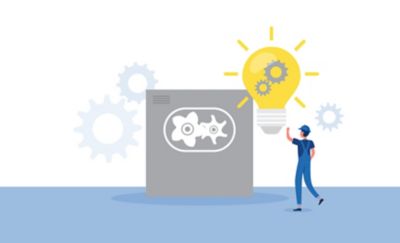Consider the initial purchase price, maintenance costs, energy efficiency, and operational costs.
When investing in compressed air, you have to consider the total cost of ownership over the entire lifecycle of the equipment. This involves looking at factors such as the initial purchase price, maintenance costs, energy efficiency, and operational costs.
With this factors in mind, you can make a more informed decision when selecting a compressor for your organization.
Understanding Air Compressor Lifecycle
The lifecycle of an air compressor encompasses the entire period from its initial purchase to its eventual disposal. This lifecycle can be broken down into several stages, including procurement, installation, operation, maintenance, and disposal. Each stage has its associated costs and considerations, which collectively contribute to the total cost of ownership (TCO) or life cycle cost (LCC).
Key Elements of Air Compressor Lifecycle
- Initial Investment: The upfront cost of purchasing the compressor and its accessories.
- Installation: Costs associated with setting up the compressor in your facility.
- Operation: Day-to-day running costs, including energy consumption.
- Maintenance: Regular servicing, repairs, and replacement parts.
- Disposal: Costs related to decommissioning and disposing of the compressor.
What affects an Air Compressor Lifespan
Several factors can influence the lifespan and overall cost of an air compressor. Understanding these factors can help you make better decisions and optimize the lifecycle costs.
Technology: The type of technology used in the compressor can significantly impact its efficiency, reliability, and maintenance requirements. Advanced technologies may offer better performance but could come with higher initial costs.
Operating Hours: The number of hours the compressor is in operation directly affects its wear and tear. Compressors used continuously will have a shorter lifespan compared to those used intermittently.
Environment: The operational environment, including temperature, humidity, and cleanliness, can affect the compressor's performance and longevity. Harsh environments may require more frequent maintenance and replacements.
Estimating the True Lifecycle Cost of a Compressor
One popular method for estimating the true lifecycle cost of a compressor is to sum of the purchase price, maintenance costs, energy costs, and other operational expenses.
The purchase price is the easiest to determine, but it is important to also consider the cost of parts and service. Regular maintenance expenses, the availability of replacement parts, and the cost of repairs play a role in the overall cost of ownership.
Components of Lifecycle Cost
- Purchase Price: The initial cost of acquiring the compressor.
- Maintenance Costs: Expenses for regular servicing, repairs, and replacement parts.
- Energy Costs: The cost of electricity or fuel required to operate the compressor.
- Operational Expenses: Additional costs such as labor, consumables, and downtime.
Energy Efficiency and Its Impact on Compressor Lifecycle
Energy efficiency is another important factor to consider when evaluating a compressor. While energy-efficient models may have a higher upfront cost, they can lead to significant savings in the long run through lower utility bills. Factors such as demand charges, air leak losses, and system pressure settings all contribute to the overall operational costs of the compressor.
Benefits of Energy Efficiency
- Reduced Energy Bills: Lower energy consumption translates to reduced utility costs.
- Environmental Impact: Energy-efficient compressors have a smaller carbon footprint.
- Long-Term Savings: Despite higher initial costs, energy-efficient models offer better ROI over time.
Maintenance and Its Role in Compressor Lifecycle
Maintenance plays a crucial role in the overall cost of ownership for a compressor. Regular maintenance ensures that the compressor operates efficiently and reduces the likelihood of unexpected breakdowns. It is essential to factor in maintenance costs when evaluating the lifecycle cost of a compressor.
Strategies for Reducing Compressor Lifecycle Costs
Reducing lifecycle costs can lead to significant savings over time. Here are some effective strategies:
- Invest in High-Quality Products: Opting for high-quality compressors may have higher initial costs but can offer better performance and longevity, reducing overall lifecycle costs.
- Opt for Reusable or Recyclable Options: Choosing compressors with reusable or recyclable components can reduce disposal costs and environmental impact.
- Rent or Borrow Instead of Purchasing Outright: For short-term needs, renting or borrowing compressors can be more cost-effective than purchasing.
- Invest in Renewable Energy Sources: Using renewable energy to power compressors can reduce energy costs and environmental impact.
- Implement Measures to Reduce Energy and Water Usage: Optimizing system settings and fixing air leaks can significantly reduce operational costs.
Get in touch with our experts today!
Understanding the lifecycle of an air compressor and the associated costs is crucial for making informed decisions. If you consider factors such as initial investment, maintenance, energy efficiency, and operational expenses, you can reduce compressed air costs and ensure reliable performance for the whole compressor's lifespan.
If you have any questions or need assistance with selecting a compressor, contact our dedicated support team. Our technicians can provide you with the right information to make an informed decision about your air compressor lifecycle.
Frequently Asked Questions
Energy-efficient models can lead to significant long-term savings through lower utility bills and reduced environmental impact.
Regular maintenance ensures efficient operation and reduces the likelihood of unexpected breakdowns, impacting overall lifecycle costs.
Focus on reliability and long-term performance by gathering information and thoroughly evaluating your options.
Get tailored advice
Still have questions after reading? Our expert is ready to help you make sense of it all and guide you to the best solution.
Write to an Expert Today – Get the answers you need.






